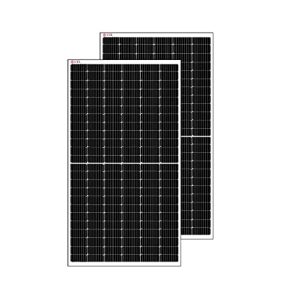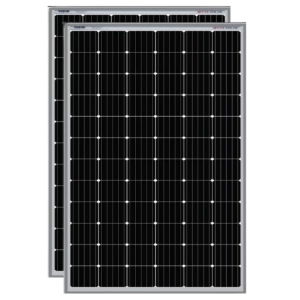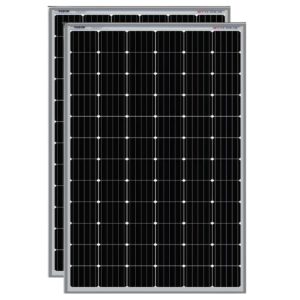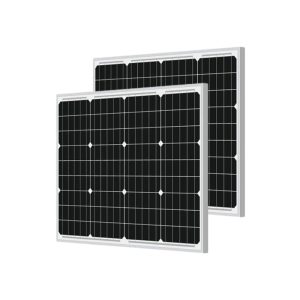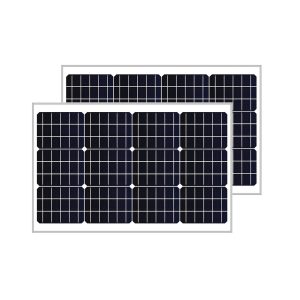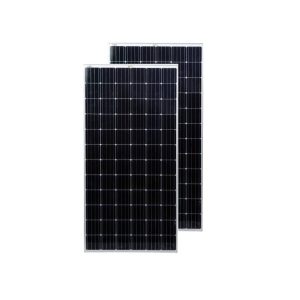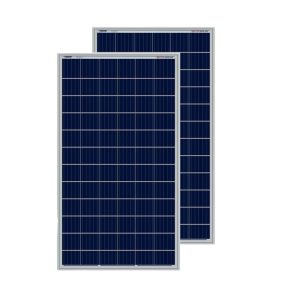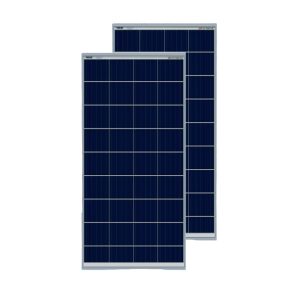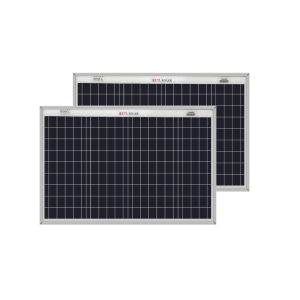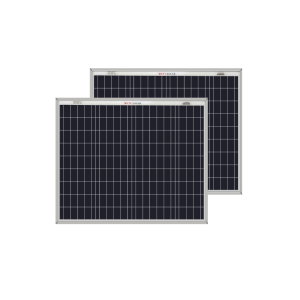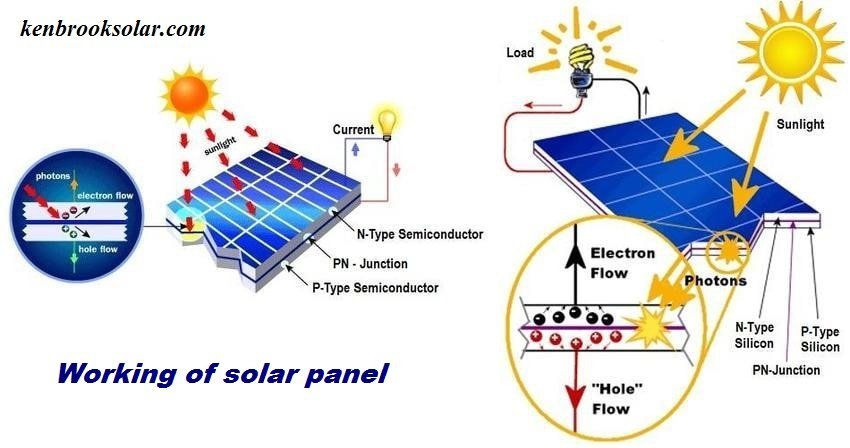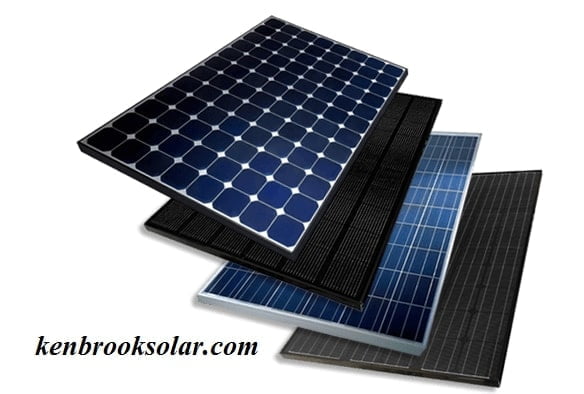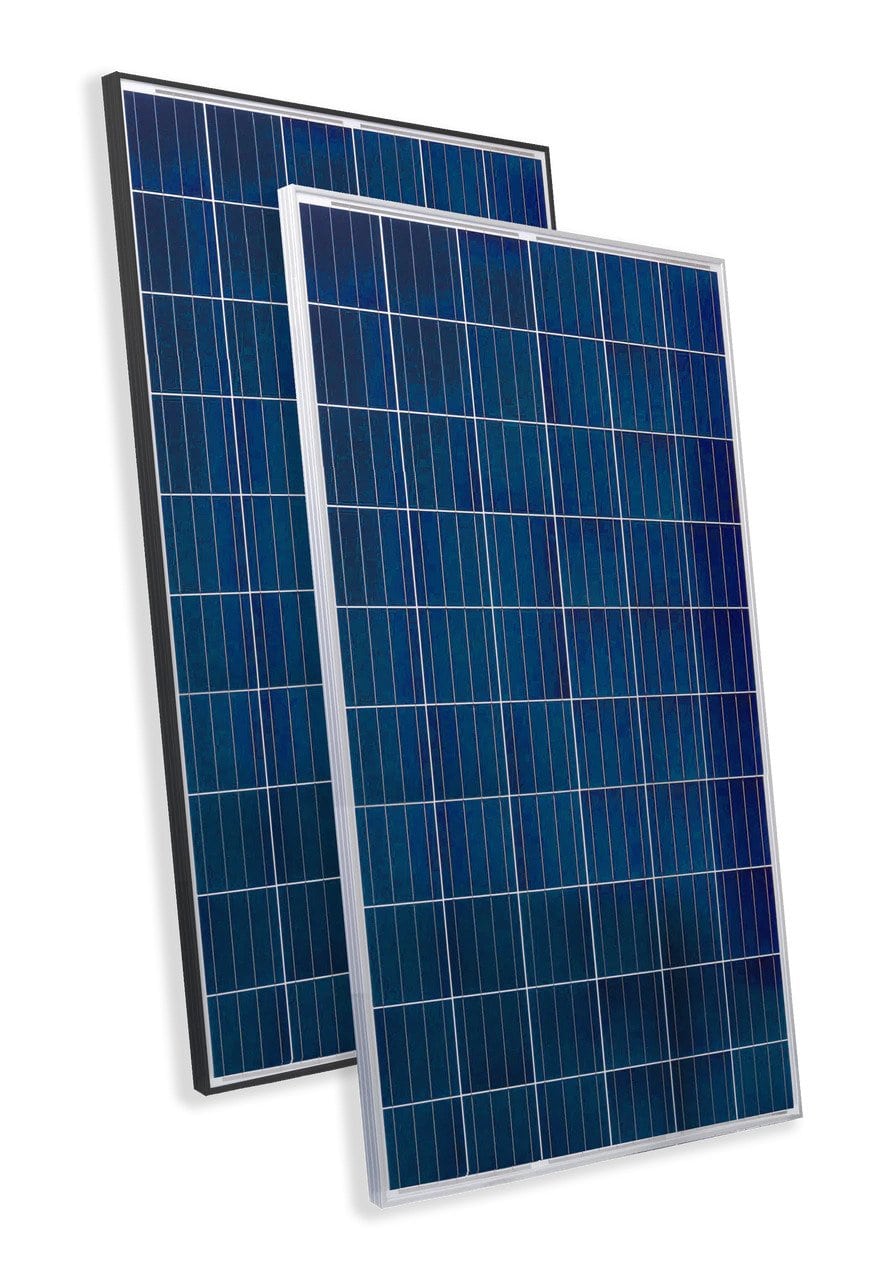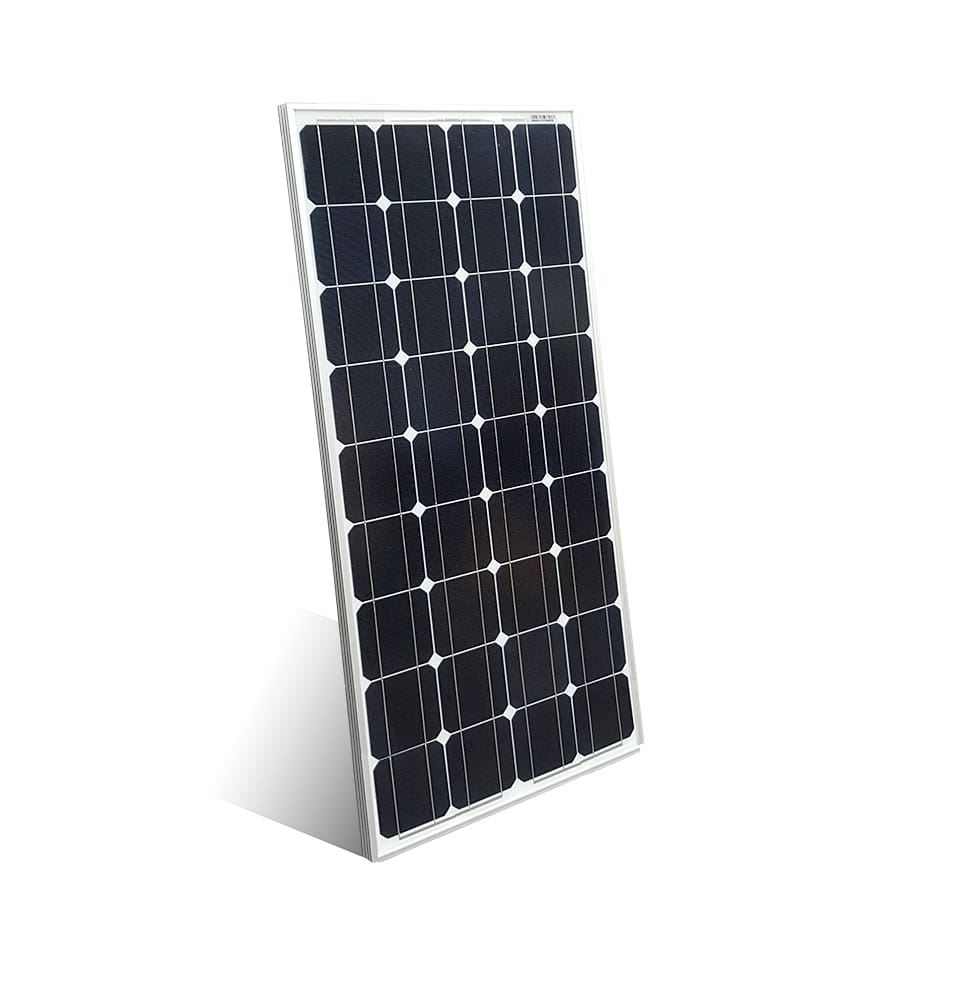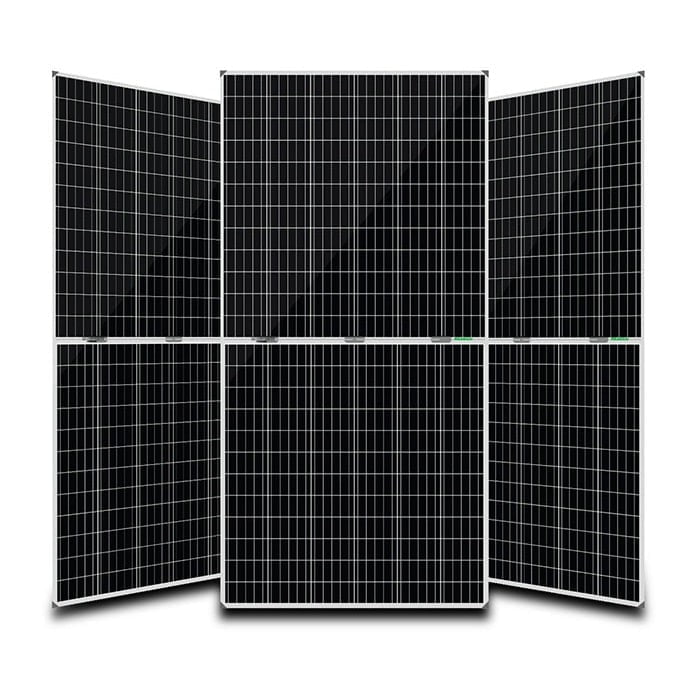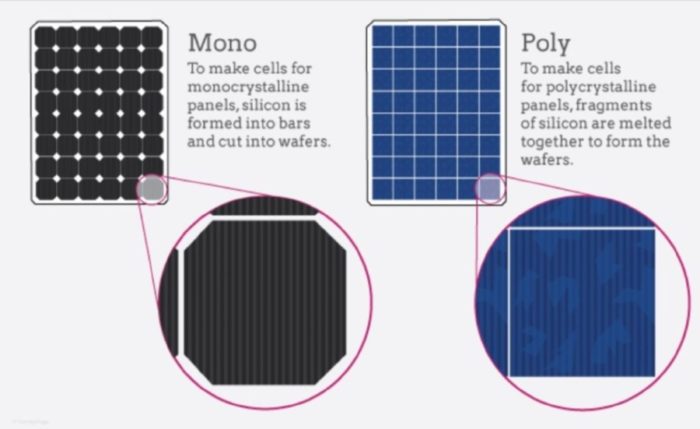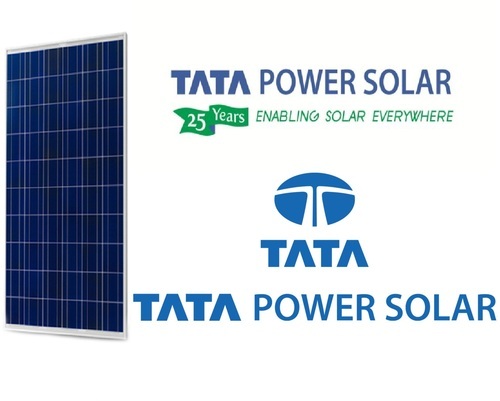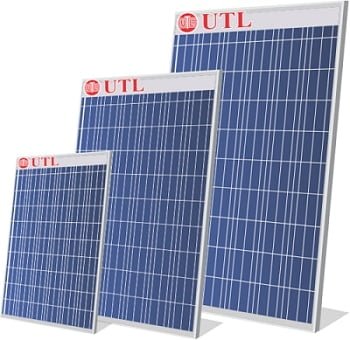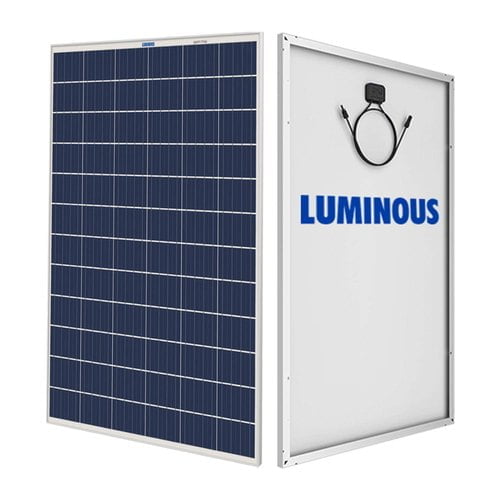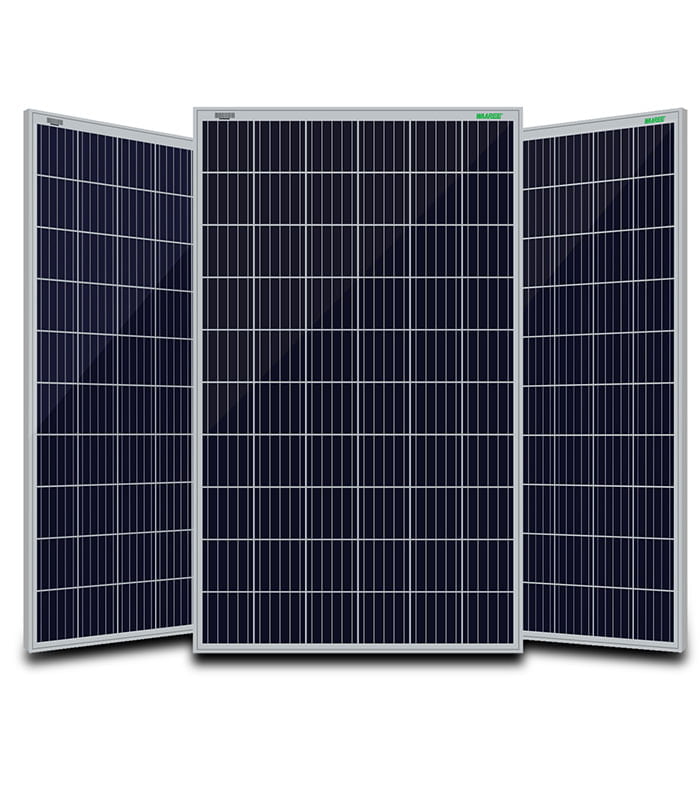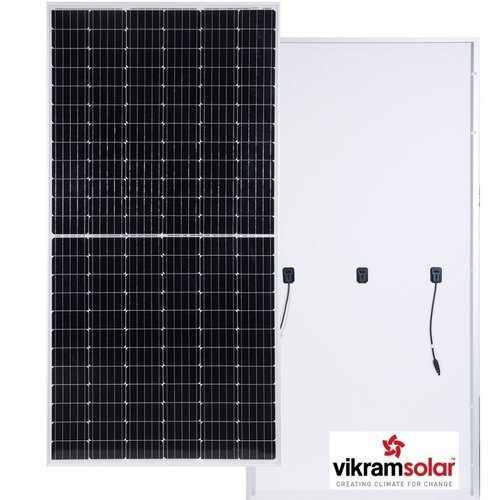Solar Panels – Price, Types, Technology, Brands & A Complete Guide
A solar panel is a collection of interconnected silicon solar cells that form a circuit. They are also known as photovoltaic solar modules, solar plates, solar PV modules, and solar power panels, etc.
Solar panels absorb sunlight and generate an electric current, which travels to your home apppliances via DC wires. On the front of the panel, there is a glass layer, followed by an insulating layer and a protective back sheet. A single solar panel can generate a certain amount of electricity. Therefore, most installations include multiple solar panels.
🇮🇳 हिंदी में पढ़े:
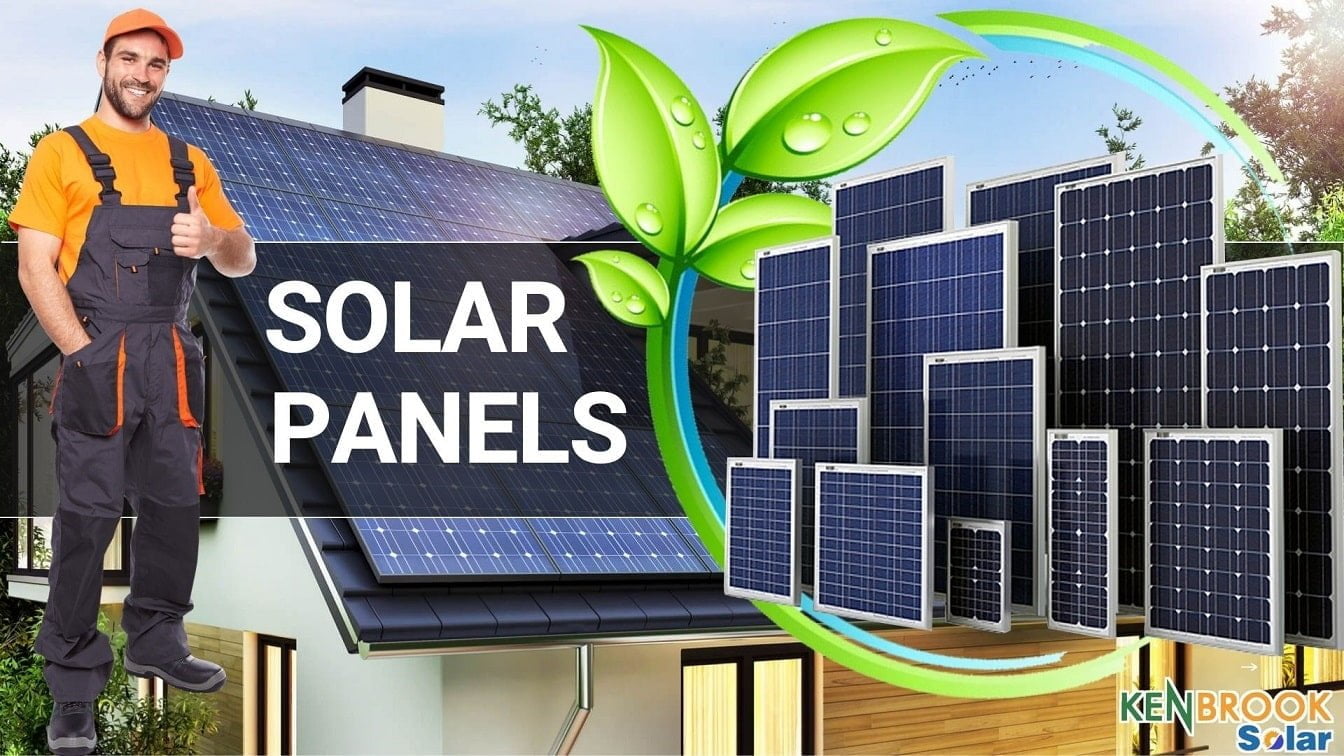
Solar cells in a solar panel are created by melting silicon fragments or silicon crystals together in a mold and cutting them into wafers. Usually, there are 60 or 72 individual crystalline silicon solar cells connected together and covered with transparent glass. The more interconnected cells in a series, the more electricity the solar panel generates.
In this article we will learn everything about solar panel like solar panel efficiency, their prices, types of solar panel and many more. So its worth spending 10 minutes reading the complete information.
UTL Solar 540 Watt 24 Volt Mono PERC
UTL Solar 445 Watt 24 Volt Mono PERC
UTL Solar 410 Watt 24 Volt Mono PERC
UTL Solar 200 Watt 12 Volt Mono PERC
Eapro 50W 12V Solar Panel Mono PERC: Portable,
Eapro 40 Watt Solar Panel Mono PERC: High
Eapro 175 Watt 12 Volt Mono PERC Solar
Eapro 400 Watt 24V Solar Panel: Mono PERC
UTL 335 Watt Poly Crystalline Solar Panel (Set
UTL Solar PV Panel 165 Watt/12 Volt Higher
UTL Solar Panel 100 Watt 12V High Efficiency
UTL 60 Watt 12V Solar Panel for Home
UTL 40 Watt 12V Solar Panel for Home
#1. How Solar Panel Works?
You’ve probably seen solar panels on rooftops in your neighbourhood, but do you know how they work? Let’s understand it in simple language. Solar panels are made of silicon solar cells. When sunlight hits a solar panel, electrons in the solar cell begin to move which initiates a flow of electricity. This is direct current, also known as DC electricity.
Unfortunately, most of our household appliances cannot be powered by direct current electricity. To convert solar power into usable electricity, it must first pass through a solar inverter. This inverter converts direct current (DC) electricity into alternating current (AC) electricity, which is compatible with most household appliances.
Read in Detail: How Solar Panel Works?
#2. What is Solar Panel Efficiency?
The efficiency of a solar panel is a measurement that tells you how well a solar panel converts sunlight into usable electricity. Assume the efficiency of a solar panel is 22%, which means it can convert 22% of the sunlight hitting it into electricity.
Solar panel efficiency is determine by several factors such as their brand, type of solar panel, and wiring & busbars, etc. Most panels have an efficiency rating between 15 to 22 percent. High-efficiency solar panels are typically more expensive. However, it is sometimes worthwhile to pay more for panels that produce more electricity.
So if you have limited roof space and are struggling to cover all of your electricity bills with solar, using high-efficiency panels can increase your long-term savings.
5 Points to Remember Before Buying Solar Panel
Solar panels are the main part of all types of the solar system. A complete solar panel system typically includes two or more solar panels, a solar inverter, a solar battery, and other accessories.
Which type of solar panel would be best for you?
By the way, there are not many technologies or types of solar panels in the market. But still, you are not a solar expert. You don’t know which type of solar panel out of monocrystalline, polycrystalline, and bi-facial solar panel will be more beneficial for you. So before buying a solar panel, it is necessary to ask a solar expert that which type of solar panel will be best for you.
Trust a 25 year old brand for next 25 years.
This is one of the most crucial recommendations to keep in mind when purchasing a solar panel. Before buying any solar panel, do a little research. Check the company profile, check the panel’s certificates. The type of testing that has been performed on solar panels is indicated by the certification. For example, IEC 61215 is one of the core testing standards that confirms a solar panel has completed several stress tests and performed well in regards to quality, performance, and safety.
Is solar really beneficial for your location?
Some states in India are far better for solar energy production than others. Surprisingly, we are not talking about the weather conditions in your state here. The weather only plays a very small factor in this because, on cloudy days, solar panels can still generate solar power. It’s your state’s electricity cost more than the weather that determines how much you can expect to save and how soon you can get a return on investment. Also, consider your state’s solar subsidies and their net-metering program.
Always choose a trusted solar brand?
Solar companies nowadays advertisements too much about their solar product to woo people. A lot of people don’t understand in the glare of these advertisements which solar panel they should buy. In such conditions, it is always preferable to seek advice from others. You can inquire from your knowns who already have installed a solar system at their homes or a solar expert. Remember, by buying solar panels, you are going to invest a large part of your earnings for a long time. So you should be careful about which solar panels you want to buy and which are not.
Check, Compare and then Buy.
Of course, the cost of solar panels has been decreasing continuously for the last few years due to the initiatives and schemes of the government. But if you are paying far less money for the same size solar panels available in the market, then be careful. You may get poor-quality panels as well as installation services. Before buying solar panels and other solar components, always do a little research about its current price in the market. Otherwise, it is quite obvious that you get what you pay for.
#3. 3 Types of Solar Panel
The growing demand for solar power is fueling advancements in solar PV technology research and development. There are currently three types of solar panels on the market. These panels are different from each other in terms of their formation, efficiency, and material. Have a look below to learn all about the different types of solar panels.
Solar panel technology has now changed and it’s going to be better as improvements in efficiency, quality, and versatility continue to develop.
Read in detail about: Polycrystalline Solar Panel
Polycrystalline Solar Panel
Polycrystalline solar panels are the most common type of solar panel. These panels are made up by pressing multiple pieces of silicon together. Polycrystalline solar panels usually have a blue mottled look.
The efficiency rate of a polycrystalline solar panel is around 16%-17%. These panels are best to work under extreme weather conditions. Polycrystalline panels are slightly less efficient than monocrystalline but they are cheaper which makes them a popular choice.
Monocrystalline Solar Panel
Monocrystalline solar panels are the second most successful type of solar panel. These panels have blackish-hue on their surface and are made by a single silicon crystal. Monocrystalline panels have solar cells in a more rounded shape with their corners cut off.
Monocrystalline solar panels tend to be more efficient than polycrystalline solar panels. Their efficiency rating is around 19%-20% because the solar cells have high purity. These solar panels are the best solar panels with the best purity and highest efficiency levels.
Read in detail about: Monocrystalline Solar Panel
Read in detail about: Bifacial Solar Panel
Bifacial Solar Panel
Bifacial solar modules offer many advantages over traditional solar panels. Power can be produced from both sides of a bifacial solar panel, increasing the total energy generation. Since more energy is transformed into electricity, fewer panels are required to satisfy the same power requirements in typical roof installations.
Bi-facial solar PV modules are often more durable too because both sides are UV resistant. When bifacial modules are installed on a highly reflective surface they can generate up to 30% more electricity from their bifacial properties.
Click to know: How You Can Earn up to ₹25.5 Lakh by Installing 10kW Solar Panel?
Yes, you heard it absolutely right. You can earn up to ₹ 25,50,000 from a 10kW solar system. Let’s learn how?
There is a thumb rule of solar that as many thousand rupees as your bill comes per month, you should install the same kW of solar system. Now just assume, your monthly electricity bill is ₹10,000/month. So according to this rule, you will have to install a 10kW solar system which will cost you around ₹4,50,000.
Now come to its ROI & working life.
The ROI (return on investment) of solar panel is very quick and you will get your money back within 45 months. If we talk about its working life, then the estimated life of any solar panel system is around 300 months (25 years).
Let’s see the calculation now.
- You invested = ₹4,50,000
- Life of solar system = 25 years (300 months)
- You will get your investment back within = 45 months (45 X 10,000/month = 4,50,000)
Hence, your solar system will generate electricity for extra 255 months (300 months – 45 months) after recovering its cost.
Now if you see, then you are generating worth ₹10,000 of electricity per month. You can sell this generated electricity to the government and earn ₹25,50,000 in those extra 255 months or you can save your own ₹25,50,000 by not paying electricity bills for 255 months (21 years and 3 months).
Monocrystalline V/s Polycrystalline Solar Panel
There are mainly two types of solar panels or modules used in rooftop and ground-mounted installations – monocrystalline and polycrystalline. However, monocrystalline v/s polycrystalline solar panels, both are the best type of solar panels. But often, they create great confusion while it comes to choose the best among them.
Here we have a comparison between both types of solar modules to make the selection process easy.
| Mono Panel | Poly Panel |
| Expensive | Cost Effecctive |
| Efficiency Upto 20% | Effeciency Upto 16% |
| Black in Colour | Blue-ish in Colour |
| Cover Less Roof Space | Cover More Roof Space |
| Better Efficiency in Low Light | Comparatively Low Efficiency |
#4. Solar Panel Price List
The most important factor that influences our mind at the time of purchasing solar panels is the “Price of Solar Panel”. Normally, the prices of panels are measured in solar price per watt. Solar panels are rated by their wattage and efficiency. A panel’s wattage is how much power it is expected to generate.
Investment in solar is big and one-time investment. So if you are going to install a solar panel at your home or business, you should know the prices of solar panels. The cost of solar panels has recently changed. For your convenience, we are providing you the price list of all capacities and brand’s solar panels below.
Tata Solar Panel Price
Tata solar panels are best in class solar panels. These are extremely efficient polycrystalline solar panels, with an efficiency rate of around 17%. Its aluminum-encased frame and tempered glass on the top, which covers all the solar cells, give it extra durability.
These solar panels are compliant with all international standards and can be used in a variety of PV applications. These solar panels are available from 50 watt 12 volt to 330 watt 24 volt at very resonable prices in India.
Read in Detail: Tata Solar Panel & Solar System Price List
| Tata Solar Panel Model | Selling Price | Price Per Watt |
|
Rs. 2,200 |
Rs. 44 |
|
|
Rs. 4,400 |
Rs. 44 |
|
|
Rs. 6,600 |
Rs. 44 |
|
|
Rs. 6,720 |
Rs. 42 |
|
|
Rs. 7,800 |
Rs. 39 |
|
|
Rs. 7,250 |
Rs. 29 |
|
|
265W Solar Panel |
Rs. 7,685 |
Rs. 29 |
|
288W Solar Panel |
Rs. 8,352 |
Rs. 29 |
|
Rs. 8,700 |
Rs. 29 |
|
|
315W Solar Panel |
Rs. 9,135 |
Rs. 29 |
|
Rs. 9,240 |
Rs. 28 |
- (Inclusive of all taxes) Prices can vary ± 10% to 12% depending on location, promotions and availability, and solar brand.
- Prices are exclusive of Govt. Subsidy, as the subsidy on solar systems depends on your eligibility and types of solar system.
- Check our Online Solar Shop or Amazon Store for the latest price and stock availability.
Read more about subsidy on solar panel here: https://kenbrooksolar.com/solar-benefits-mnre-govt-subsidy
UTL Solar Panel Price
UTL solar panels are best-in-class solar modules produced on cutting-edge module manufacturing lines. The panels have a strong, light-weight anodized aluminium frame and a unique back sheet for high moisture resistance.
These panels are completely reliable in extreme weather conditions, having been certified to withstand heavy snow loads. The company produces highly efficient polycrystalline solar panels ranging in wattage from 40 to 330 watts.
Read in Detail: UTL Solar Panel Price With Complete Details
| UTL Solar Panel Model | MRP | Selling Price |
| 40 Watt Solar Panel | Rs. 3,334 | Rs. 1,856 |
| 60 Watt Solar Panel | Rs. 4,174 | Rs. 2,375 |
| 100 Watt Solar Panel | Rs. 6,628 | Rs. 3,686 |
| 160 Watt Solar Panel | Rs. 9,346 | Rs. 5,242 |
| 330 Watt Solar Panel | Rs. 16,489 | Rs. 9,603 |
- (Inclusive of all taxes) Prices can vary ± 10% to 12% depending on location, promotions and availability, and solar brand.
- Prices are exclusive of Govt. Subsidy, as the subsidy on solar systems depends on your eligibility and types of solar system.
- Check our Online Solar Shop or Amazon Store for latest price and stock availability.
Luminous Solar Panel Price
Luminous solar panels are the most widely used solar panels because of their high efficiency. These solar panels are manufactured by pouring small molten silicon fragments into a mold. They are then framed and covered with glass sheets.
Solar panels by Luminous Solar are the best value panels for your home and other PV applications. If you want cost effective solar panel solution, you should install Luminous solar panels.
Read in Detail: Luminous Solar Panel, Inverter, Battery & All Products
| Model (Watt) | Price (Rs.) | Price /Watt |
| 40W Poly Solar Panel | Rs. 1,800 | Rs. 45 |
| 60W Poly Solar Panel | Rs. 2,700 | Rs. 45 |
| 75W Poly Solar Panel | Rs. 3,000 | Rs. 40 |
| 100W Poly Solar Panel | Rs. 3,800 | Rs. 38 |
| 160W Poly Solar Panel | Rs. 5,600 | Rs. 35 |
| 200W Poly Solar Panel | Rs. 7,000 | Rs. 35 |
| 200W Poly Solar Panel | Rs. 6,200 | Rs. 31 |
| 270W Poly Solar Panel | Rs. 8,370 | Rs. 31 |
| 325W Poly Solar Panel | Rs. 10,075 | Rs. 31 |
| 335W Poly Solar Panel | Rs. 10,385 | Rs. 31 |
- (Inclusive of all taxes) Prices can vary ± 10% to 12% depending on location, promotions and availability, and solar brand.
- Prices are exclusive of Govt. Subsidy, as the subsidy on solar systems depends on your eligibility and types of solar system.
-
Check our Online Solar Shop or Amazon Store for latest price and stock availability.
Waaree Solar Panel Price
Waaree solar panels are well-known for producing consistent amounts of energy even in adverse weather conditions. These solar panels are extremely long-lasting and they require no special maintenance.
Waaree solar panels are ideal for both residential and commercial installations. Once installed, these panels will function flawlessly for years.
The price of a Waaree polycrystalline solar panel starts at Rs.25 per watt for a 330 watt solar panel, and the price per watt for smaller capacity solar panels is around Rs.35
Read in Detail: Waaree solar panel price with complete details
| Model/ Watt | Selling Price | Price Per Watt |
| Waaree 330w Solar Panel | Rs. 8,250 | Rs. 25 |
| Waaree 325w Solar Panel | Rs. 8,125 | Rs. 25 |
| Waaree 320w Solar Panel | Rs. 8,000 | Rs. 25 |
| Waaree 270w Solar Panel | Rs. 6,750 | Rs. 25 |
| Waaree 200w Solar Panel | Rs. 5,000 | Rs. 25 |
| Waaree 160w Solar Panel | Rs. 5,600 | Rs. 35 |
| Waaree 100w Solar Panel | Rs. 3,500 | Rs. 35 |
| Waaree 75w Solar Panel | Rs. 2,625 | Rs. 35 |
| Waaree 50w Solar Panel | Rs. 1,750 | Rs. 35 |
- (Inclusive of all taxes) Prices can vary ± 10% to 12% depending on location, promotions and availability, and solar brand.
- Prices are exclusive of Govt. Subsidy, as the subsidy on solar systems depends on your eligibility and types of solar system.
-
Check our Online Solar Shop or Amazon Store for latest price and stock availability.
Vikram Solar Panel Price
Vikram solar panels are cutting-edge solar panels that are designed with high-quality materials. Solar cells in these solar panels are designed to achieve a high energy efficiency.
The company provides a full range of solar panels ranging in capacity from 50 watts to 330 watts. Vikram solar manufactures high-quality solar panels with an aluminium frame and high-quality glass for protection. The prices of these solar panels are listed below.
Read in Detail: Vikram Solar Panel – Poly, Mono & Bifacial Solar Panel
| Solar Panel Model (Watt) | Selling Price | Price /Watt |
|
Rs. 1,900 |
Rs. 38 |
|
|
75 Watt Solar Panel |
Rs. 2,850 |
Rs. 38 |
|
Rs. 3,300 |
Rs. 33 |
|
|
160 Watt Solar Panel |
Rs. 5,280 |
Rs. 33 |
|
Rs. 5,600 |
Rs. 28 |
|
|
270 Watt Solar Panel |
Rs. 7,560 |
Rs. 28 |
|
320 Watt Solar Panel |
Rs. 8,960 |
Rs. 28 |
|
325 Watt Solar Panel |
Rs. 9,100 |
Rs. 28 |
|
330 Watt Solar Panel |
Rs. 9,240 |
Rs. 28 |
- (Inclusive of all taxes) Prices can vary ± 10% to 12% depending on location, promotions and availability, and solar brand.
- Prices are exclusive of Govt. Subsidy, as the subsidy on solar systems depends on your eligibility and types of solar system.
- Check our Online Solar Shop or Amazon Store for the latest price and stock availability.
#5. Subsidy on Solar Panel
To promote “Green energy, Clean energy” in India, the government is providing subsidies on solar through MNRE (Ministery of New and Renewable Energy). You can get up to 90% subsidy on solar depending on your location and purpose of installing a solar system. Below, you can get a brief idea for a subsidy on solar in India.
- 90% subsidy on Solar Water Pumping System for farmers only.
- 70% subsidy for 3 hill states i.e. Himachal Pradesh, Uttarakhand & Jammu-Kashmir.
- 30% subsidy for all states of India.
Learn more about: Subsidy On Solar – Panel, System, Pump & Solar Product
#6. Maintenance of Solar Panel
Solar panels are a zero-maintenance solar product. However, it is mandatory to clean solar panels regularly to remove dust particles that accumulate on their surface.
Regular cleanings will increase the efficiency as well as the working life of your solar panels. For cleaning solar panels we recommend using a solar panel cleaning kit. However, you should take precautions and keep the below mention things in your mind about solar panels.
- Do not apply pressure on PV photovoltaic panels by sitting or stepping on them.
- Make sure solar panels are properly earth grounded to prevent electrical shock.
- Do not bring flammable gas or explosive materials near solar panels.
- Never touch any electrical connections or wiring without proper protection.
- When working on your solar system, avoid wearing metallic jewelry as it may cause electric shock.
#7. Features of Solar Panel
-
High Efficiency
Solar panels are the best and cheapest means of generating electricity. The generation capacity of solar panels is really great i.e 17% to 22%. But solar panels of some reputed brands can be even more than 22% efficient.
-
Rough & Tough
Solar panels are very tough in quality. When it comes to wear and tear, then the solar panels hardly degrade 1% or sometimes even less in a year. If you have installed solar panels at your places then they will operate without any trouble for decades
-
Attractive Appearance
Solar panels nowadays are sleek, and highly aesthetically pleasing. They also have an attractive transparent glass cover on their surfaces. not only reduce your electricity bills but they automatically give an attractive look to your house.
-
Safety with Aluminum Frame
Solar panels are covered from all sides by an aluminum frame. These aluminum frames are lightweight as well as very strong. It provides complete protection to solar panels so that they work for years without any problem.
-
Low Maintenance
Solar panels are a maintenance-free product. You do not need to spend much money on their maintenance. They only need to wash with water and soap/shampoo once a week. Once you install solar panels, you can forget them straight for 25 years.
#8. Pros & Cons of Solar Panel
- Advantages
- Increase your property value
- 25 years long working life
- 30% to 70% government subsidy on solar panel
- Get green energy & save the environment
- Low maintenance cost
- Reduce electricity bills
- Freedom from centralized grids
- Great Rate of Return On Investment
- Get free electricity after 3 years
- Only one-time investment
- Fully customizable and portable
- Disadvantages
- Weather dependent
- Required large shadow-free area
- Heavy one-time investment
- Weekly cleanings
Frequently Asked Question
Yes, but not directly. You can run any size of air conditioner on solar system. If you are going to install an air conditioner to run on solar power then we recommend you to buy solar AC.
If you already have a solar inverter and solar battery and you require only solar panels then it will cost you around 30,000 including the charge controller. For buying a complete system please visit – 1kW solar system.
For buying any capacity or brand solar panel, you can contact us. You can also buy it online from our online solar store.
Yes, you can run the computer center on a solar panel system. Generally, the computer lab has 10 to 15 desktop computers, 4 fans, 2 exhausts, 1 cooler, and 4 tubes light, customers can choose a 3 kW solar system.
Solar panel installation cost starts from Rs.2 per watt to cost Rs.10 per watt. Depend upon the capacity of the solar system, location, and type of solar system.
Approximately 6 square meters of the shadow-free area is required per kilowatt solar system. And in a 1kW solar system, 3 nos. of 335-watt solar panel is used.
The first thing is that roof should be free of shadow. Solar panels are not laid down directly on your rooftop, the solar panel takes place on mounting structures that can be customized according to your rooftop. If there is proper sunlight then yes, solar panels are suitable for any kind of rooftop.
Yes, a DC fan can be run directly on a solar panel through a charge controller. In the case of an AC fan, a solar inverter is must in the solar system because the solar system generates DC form of electricity.
Of course, a solar panel can be used with all types of solar system including off grid solar system.
1kW panel can save around Rs.1,000 per month on an average of all seasons.
Solar panels are a low-maintenance product however, it is mandatory to regularly clean solar panels to remove dust particles that accumulate on solar panels. You need to buy solar panel cleaning kit worth Rs. 3,000 to 5,000 (depends on its model).
Solar panels come with 25 years warranty in top solar brands in India. However, the lifespan of a solar panel can go up to 30 years depending upon the brand and quality of the solar panel.
Yes, a solar panel will produce relatively less energy during the monsoon. Shades, clouds, and monsoons do affect the performance of solar panels. The rays of the sun falling on the solar panel are related to the amount of electricity.
The sunlight falling on the solar panels is converted into electricity. This electricity from the solar panel is in DC (direct current) form and since we use alternating current to drive devices in our home, a solar inverter is installed to convert this direct current to alternating current.
Tata Solar, Luminous Solar, Havells Solar, Vikram Solar, Waaree Solar, Adani, etc are the best solar panel companies in India.

